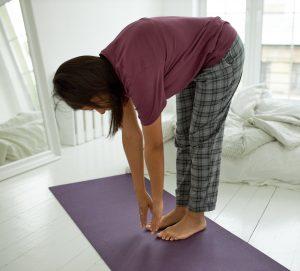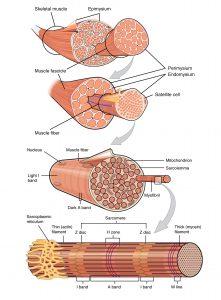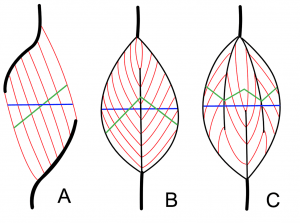
By Bernie Clark, September 10, 2021
This is a fun discussion! On the one hand there are yoga teachers who tell their students that a consistent yoga practice will make their muscles longer thus increasing their range of motion. Their own experience is all the proof they need. Over years of practice, they have become demonstrably more flexible so their muscles must have become longer. On the other hand are teachers citing research that says it is not possible to lengthen muscles and the only reason that yoga can make you more flexible is due to changes in your nervous system. We can train our muscles to relax, which make them easier to stretch, but we can’t make them longer. Both camps agree that yoga improves flexibility but disagree on how this happens. Who has it right? Well…it depends! Both may be correct.
Muscles have fixed attachment sites
One of the points raised by the “yoga doesn’t lengthen muscles” camp is that “you can’t change where muscles begin and end”. The attachment sites of the muscles are to the bones and the bone lengths don’t change, therefore muscle length won’t change either. However, this point ignores the fact that the distance between a muscle’s attachment sites is highly variable.[1] What is important is the angle of the joint that the muscle crosses, not the length of the bones. When your hips are fully extended and the knees fully flexed, the top of your hamstrings, which attach to the ischial tuberosities of your pelvis (aka—the sitting bones) is closer to the bottom of the hamstrings, which attach to the back of your lower leg (tibia). However, these two points are quite a bit further apart when you try to touch your toes with legs straight and hips flexed (see figure 1.) The fact that your femur doesn’t change length is irrelevant. What is important is the relative position of the attachment sites throughout your full range of motion. If your muscles are “short” these attachment sites will be closer together than when your muscles are “long”.
However, there is a limit to how far apart the attachment sites can go, and thus how open a joint can become. At the point where compression limits range of motion, the joint cannot open any further. Now, there is no way to increase the distance between the muscles’ attachment sites. This means that there is no way to lengthen the muscles beyond this distance. Consider the simple example of your arm’s bicep muscles: when the elbow is fully flexed, the bicep is shortest. When the arm is fully straightened, including whatever degree of hyperextension your elbow possesses, if you are stopped by compression of the ulna against the humerus[2], then the bicep is as long as it can possibly get.[3] It is logical to assume that Yoga will not make the bicep muscles longer than that. But, the story is not so simple! Yoga may actually increase your muscle length even though the attachment sites do not change.
The architecture of a muscle
As shown in figure 2, the architecture of a muscle can be described as a series of tubes within tubes within tubes. At the gross level, we have the whole muscle—let’s call it the semimembranosus (one of the hamstrings). The whole muscle is wrapped in a fascial tube called the epimysium. Within the muscle is an array of smaller tubes called muscle fascicles, which have their own fascial wrappers, called the perimysium. Within those tubes are smaller tubes called muscle fibers, wrapped by the endomysium. These muscles fibers are the muscle cells, but so strange are these cells that they are rarely referred to as such (some muscle cells can have hundreds of nuclei and thousands of mitochondria.[4]) Instead they are called fibers. But, the tubes within tubes don’t stop there: within the fibers are even smaller tubes called myofibers. These are made up a plethora of contractile units called sacromeres. More about the sarcomeres later.

Figure 2 doesn’t really show how the muscle fibers are orientated within the muscle. Rarely do the fibers run longitudinally within the muscles. More often, as shown in figure 3, they run at an angle to the long axis of the muscle. This is called pennation, which is Latin for winged or feathered. The red lines show the orientation of the muscle fibers within a full muscle. Notice that they do not run along the long axis of the muscle. The horizontal blue lines indicate the muscle’s diameter, but the green lines indicate the cross section of the muscles at right angles to the muscles fibers length. Since muscle strength is proportional to the cross section of the muscle fibers and not the diameter of the overall muscle, the orientation of the fibers is very important. The bigger the cross section of the muscle (the green line), the stronger the muscle.

As body builders and weight lifters know, muscles can get bigger through resistance training. Thanks to pennation angles, when the cross section (green lines) gets wider, there is a longitudinal component of growth that will increase the muscles length as well. Thus, building stronger muscles can often create not just bigger muscles but also longer muscles![7]
How muscles grow
As shown at the bottom of figure 2, the engine of the muscle is an activating unit called a sarcomere. We don’t need to go into the theory of how they do their thing, but basically when a sarcomere is activated, it tries to pull itself shorter. This creates a force. The force may indeed shorten the muscle, but if the outside force being resisted by the muscle is larger, then the muscle can lengthen even though it is actively trying to shorten. In this way muscles can act as breaks to movement. Think of what happens when you lower down from upper plank position into Chaturangadandasana. Your triceps are engaged to slow your descent but they are lengthening as well. (This is called eccentric lengthening.)
Sarcomerogenesis
The growth of a muscle fiber is called hypertrophy. This growth happens through the addition of sarcomeres and that is called sarcomerogenesis.[8] There are two possible ways to add sarcomeres within a muscle fiber: in parallel to the existing sarcomeres or in series with them. When sarcomeres are added in parallel, the muscle fiber gets thicker (its cross section increases). When sarcomeres are added in series, the fiber gets longer.
Clearly muscles can and do get longer as we mature. Your leg and arm muscles are much longer now than when you were 10 years old. Thus, the body innately has an ability to lengthen muscles. Some people suffer joint contracture which can lead to the body reabsorbing sarcomeres, causing the muscles to shrink to the new range of motion available at that joint. However, with therapy the contracture can sometimes be reversed, which triggers the body to rebuild the number of sarcomeres within the muscle, making it longer again.
When a sarcomere is chronically loaded (or stressed) it stretches, but there is a preferred length for sarcomeres, which is generally around 2.5 micrometers. If the sarcomere is continuously stretched beyond that length, the body will react by building another sarcomere added in series to the existing ones, thus the muscle fiber becomes longer. There are many references to muscle fiber elongation in the technical literature. (The interested student can dive deeper into this topic by reviewing the study listed in footnote 9[9].) The point is—muscle lengthening has been noticed since the time of the early Greek philosophers and has been shown repeatedly in modern experiments.[10] Muscle fibers can and do grow longer and thicker through the above process.
Limits to our flexibility
So, Virginia, it is possible that your yoga practice is lengthening your muscles! However, that is certainly not all that is happening, and indeed it may be that your muscles have not changed their length. Just because something can happen, does mean it will happen. There are other factors that limit our flexibility. Some people naturally have a large amount of muscle tonus. Muscle tonus is the passive (beyond our conscious control) activation of a small percentage of our muscle fibers and helps us to maintain our posture and protects us against sudden stresses on our joints. Unfortunately, some people have very large tonus, which can be called contracture or spasticity. They have too much resting activation of muscle fibers and as a result have limitations to their flexibility. Other people have very little tonus and are very loose in their joints. Again, it is beyond the scope of this article to describe how our muscle spindles (which turn on our muscles), Golgi tendon organs (which turn off our muscles) and our nervous system dictate how much tonus we have.[11] What is important to know, though, is that through our yoga practice, we can down regulate the nervous systems activity and reduce the resting tonus, which increases our range of motion.
The state of our fascia is another factor in our flexibility. Whether or not there are adhesions between the otherwise sliding surfaces of the fascial tubes inside our muscles or between larger groups of muscles can reduce flexibility. Our immune system can also affect the state of our fascia, as can hormonal variations that occur during a woman’s monthly menstrual cycles. Indeed, there are many factors that can make us stiff, and when addressed lead to larger ranges of motion. Thus, the length of muscles, which can be a factor in our flexibility, is just one potential limitation.
When short tight muscles are contributors to our inflexibility, they can be lengthened over time. But, they are not the only things that may be stopping us.[12]
Thus, both camps may be right: our muscles can lengthen over time thanks to our yoga practice, but often, this is not what happens even though we do get more flexible. There are other factors at play that may be helping us become more mobile. In the end, do we really care? As long as we can regain and maintain our optimal mobility, our practice is serving us well.
_______________________________
[1] This argument also misses the fact that muscles often do not connect to bone but often to tendons. Sometimes muscles connect to fascial expansions, joint capsules or to the tendons of other muscles. If these tissues contract, then the muscles may lengthen to compensate. So, while it is true that bone lengths don’t change (barring illness, aging or some specific conditions) other tissues can and do change their size.
[2] This happens when the olecranon of the proximal ulna abuts the olecranon fossa of the distal humerus.
[3] For simplicity’s sake, I am ignoring the proximal attachment of the biceps at the scapula which can also affect its length.
[4] Bruusgaard JC, Liestøl K, Ekmark M, Kollstad K, Gundersen K. Number and spatial distribution of nuclei in the muscle fibres of normal mice studied in vivo. J Physiol. 2003;551(Pt 2):467-478. doi:10.1113/jphysiol.2003.045328
[5] The illustration of skeletal muscles is copied with permission under the Creative Commons Attribution 4.0 International license and adapted for this review, available online: https: //openstax.org/books/anatomy-and-physiology/pages/10-2-skeletal-muscle (accessed on September 1, 2021.) Betts, G.J.; Kelly, A.Y.; Wise, J.A.; Johnson, E.; Poe, B.; Kruse, D.H.; Korol, O.; Johnson, J.E.; Womble, M.; DeSaix, P. Anatomy and Physiology; OpenStax: Houston, TX, USA, 2013.
[6] Illustration from the Creative Commons Attribution-Share Alike 3.0 Unported license from original work by Uwe Gille (Available online: https://creativecommons.org/licenses/by-sa/3.0/deed.en (accessed on September 1, 2021).
[7] However, how the weightlifter trains makes a difference. If all training is done concentrically, which means the muscles are only engaged under stress while shortening, the muscles may end up shorter. If the muscles are engaged under load while lengthening (think of the slowly lowering phase of a push-up: the triceps are under load and slowly lengthening), they will become longer. Thus, many weightlifters’ muscles get thicker and longer.
[8] Zöllner AM, Abilez OJ, Böl M, Kuhl E. Stretching skeletal muscle: chronic muscle lengthening through sarcomerogenesis. PLoS One. 2012;7(10):e45661. doi: 10.1371/journal.pone.0045661. Epub 2012 Oct 1. PMID: 23049683; PMCID: PMC3462200.
[9] Jorgenson KW, Phillips SM, Hornberger TA. Identifying the Structural Adaptations that Drive the Mechanical Load-Induced Growth of Skeletal Muscle: A Scoping Review. Cells. 2020 Jul 9;9(7):1658. doi: 10.3390/cells9071658. PMID: 32660165; PMCID: PMC7408414.
[10] How the muscles get longer is still under investigation. While most researchers believe elongation occurs through hypertrophy, which is the addition of more sarcomeres, there is a school of thought that believes growth happens through hyperplasia, which involves the addition of new muscle fibers through the splitting of existing fibers. For our purposes, this point is moot because in either case, the overall muscle gets longer, even if the individual fibers may or may not.
[11] The interested student can read more in my book Your Body, Your Yoga, Wild Strawberry Productions, 2016, pages 47-48.
[12] Again, more details on the topic of “What stops me?” can be found in Your Body, Your Yoga.
